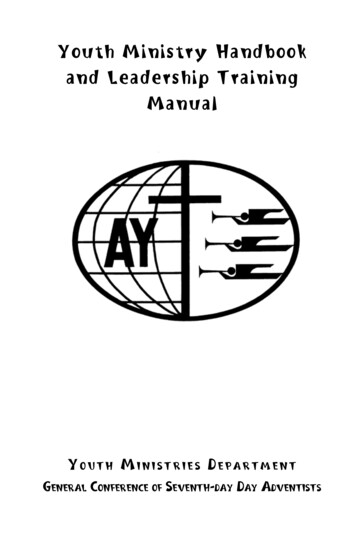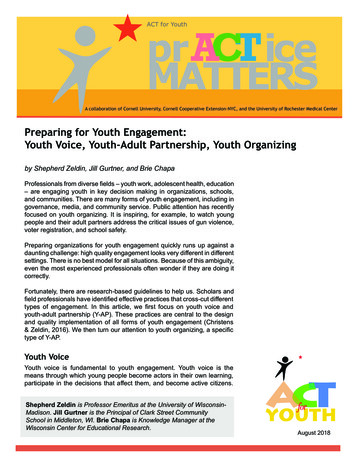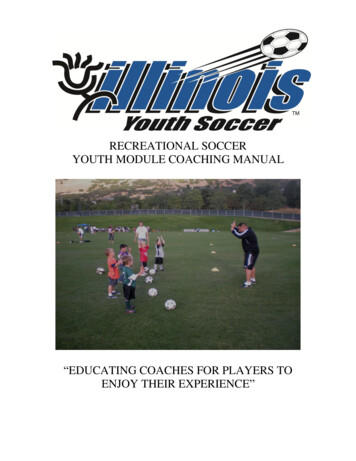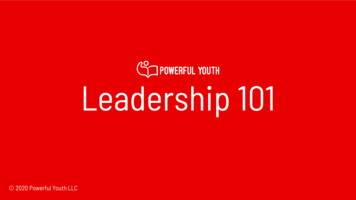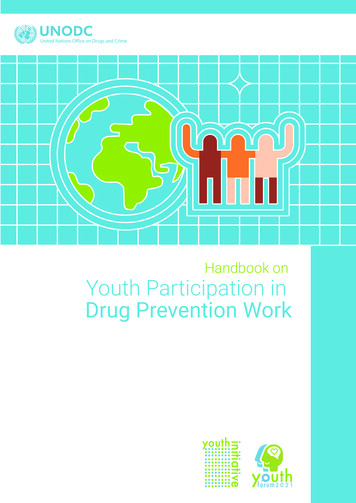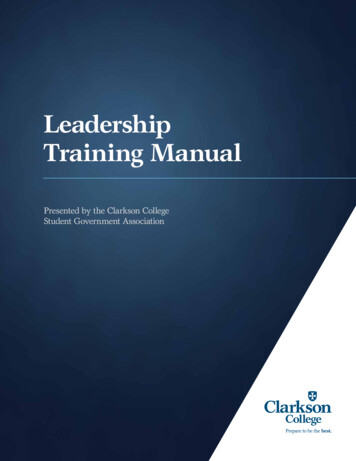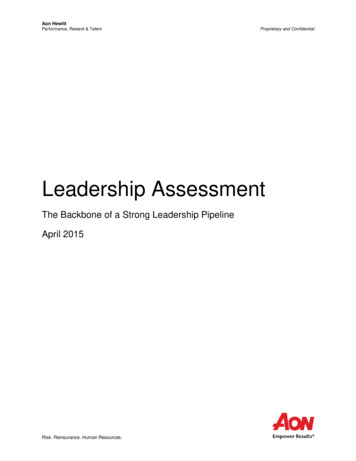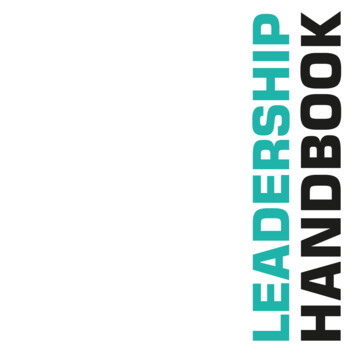
Transcription
Leadership HandbookSarajevo, 2017.
Leadership HandbookPublisher:South East European Youth Network – SEEYN SecretariatSkenderpašina 1, 71000 Sarajevo, Bosnia and Herzegovinawww.seeyn.orgAuthors:Helena KovačMartina ŠirolMarinela ŠumanjskiLayout and cover design:Lidija NovoselPrinting:Blicdruk d.o.o.Ćemaluša 871000 Sarajevo, Bosnia and HerzegovinaThis handbook has been made with financial support of EuropeanUnion, through Erasmus programme, Key Action 2.The European Commission support for the production of thispublication does not constitute an endorsement of the contentswhich reflects the views only of the authors, and the Commissioncannot be held responsible for any use which may be made of theinformation contained therein.
contentswhat will you learn from this handbook?06Block 1:Why this HandbookBlock 2:Intro to Youth Work07About the handbook and its team . 9SEEYN and the Project . 1113Youth work and volunteering . 15Youth work . 15Volunteering . 16Values of youth work and volunteerism . 16Benefits . 18Youth activities and types . 19Block 3:Me, the Leader21Understanding Leadership . 23Leadership styles . 24Leadership roles . 27Leadership competences . 28Knowledge . 28Attitude, Values and Motivation . 28Leadership skills . 28Emotional Intelligence . 30Teambuilding and group dynamics . 35Teams and groups . 37Group dynamics . 38Managing the group and delegation . 43Working with groups . 43Delegation . 45Communication . 46Verbal and Nonverbal communication . 46Listening skills . 48Giving and Receiving Feedback . 48
Leadership Challenges and Conflict Resolution . 52Defining conflict . 52Conflict management . 53Inclusion and participation . 57Leadership challenges . 59Cultural diversity . 61The Onion model of culture . 62Differences within our own culture . 62Cultural crash and stages of acceptance . 63Block 4:Leadership in Practice67Planning Your Initiative . 69Need assessment . 70Project Aims: Addressing the needs . 71Project Activities: Reaching Objectives . 73Resources and resource management . 75Resource management . 75Budgeting and fundraising . 78Budgeting . 78Fundraising . 79Approaches to finding the money . 80Unexpected costs and what to do with them . 82Financial report . 82Monitoring and Evaluation . 83Monitoring . 83Evaluating . 84Reporting . 87Protection and safety . 88The role of youth leaders . 88Responsibility . 88The basics of protection . 89What is harmful . 90Risk assessment . 92Visibility and PR . 93Public Relations (PR) . 93Print media . 94Digital media . 96Social media . 96Radio . 96
Table of ContentsTV . 97Public events . 97Organization and its culture . 100Organizational Culture . 100Youth activism and initiatives . 102Why Youth Leadership? . 102IDEA BOX: Local community project – United for ourcommunity . 105further reading106
What will you learn from this Handbook?The Leadership Handbook is made of 4 learning blocks and together they make the whole youth leadership capacity buildingstructure:1. WHY THIS HANDBOOK3. ME, THE LEADERThis block will explain the idea and aim behind the creationof this Handbook and who are the people who contributedto its development. Hi reader!This is the block that will firstly explore the meaning of theleader and its types, and then it will help you work on yourleadership competences. It will lead you through range ofdifferent knowledge, skills and attitudes which we considerimportant for the good leader. Can you see yourself here?2. INTRO TO YOUTH WORKHere you will slowly enter the main topics of our Handbookand you will get introduced with the youth work and volunteering – the worlds of youth leaders. Welcome!4. LEADERSHIP IN PRACTICEThere is no leadership without action, which is why in thisblock we present you with the main elements of successfulactivity planning. We hope to empower and motivate you tomake initiative and take action in your hands. Go you!After all, remember, this Handbook is your support and can be your inspiration, but so muchdepends actually on you! Imagine it as a house, equipped with basic furniture sufficient forbasic living. Now it is up to you to nicely decorate it and improve the house with your effort,curiosity, experience and self-development in the field of youth leadership.6
Block 1
Why thisHandbook
About the handbook and its teamDear reader,Welcome to the Leadership Handbook! The book which you are about to enter was developed to support,inspire, motivate, draw attention to and raise quality of youth work. This Handbook is part of the supportsystem for youth workers, youth leaders, youth educators, youth organizations and institutions who careabout the quality of their work with and for young people. SEEYN and its partners wanted to provide theconcrete tool to build capacities of people working in youth field and are taking important role of leaders invarious youth activities and programs of their organizations and beyond.“Leadership Handbook” is a manual on organizing and leading local and international youth activities withmain focus on youth inclusion, active participation of young people and volunteering as tool for youth work.The handbook also covers topics like project and organizational management, communication, visibility andteamwork. This handbook is partially based on previous 2 editions of “SEEYN Workcamp Handbook” thatbecame recognized worldwide over last 10 years.However, this publication widens the concept of youth leadership and activities where it can be applied, itgives complete package of skills, knowledge and attitudes for youth leaders through range of useful practicalexamples and valuable theoretical background. It has been developed thanks to many years of SEEYNexperience and expertise in youth work, youth leadership and capacity building. With this Handbook, wewanted to contribute to recognition of youth work, high quality of youth activities, efficient youth programmanagement and sustainability of organizational resources and capacities. Why? Because we strongly believein youth and we know that with the quality support and positive empowerment they can make this worldthe better place.This handbook is part of the long-term SEEYN project “Practical Guide Through YOUth Work” with thesupport of the European Union, within the Erasmus programme, Key Action 2 (Capacity building in thefield of youth).Marinela ŠumanjskiSEEYN Training Manager9
About AuthorsHelena KovačHelena thinks that anything in youth work can be made interesting and inspiring if a person is willing to learn. Also,curious youth workers make for good role models and shebelieves that a good youth worker can motivate others tosee learning as a precious activity intertwined with life. Welive, we learn, yet Helena can still waste a lot of her timetrying to memorise small irrelevant information which sheinevitably forgets.Martina ŠirolMartina believes that true blessing comes from work whichbetters other people’s lives. She is passionate about youthwork, social equality and justice. She is a strong advocate ofexperiential and individualised learning. Her opinion is thateveryone has at least one extraordinary characteristic. Hersis not giving up. Even when everyone begs her to stop as hersinging is unbearable.Marinela ŠumanjskiMarinela strongly believes and commits herself to values ofvolunteering, solidarity, respect and fight for human rightsand empowerment through learning and experience. She seesyouth work as the key that unlocks all the potentials of youngpeople. She also thinks that a good chocolate cake can resolvealmost every issue.10
1: Why this HandbookAcknowledgementsWe thank Mirela Rajković, Milivoje Lujić, Saša Jovljević, EditaMilišić, Cihan Kılıç and Dani Prisacariu on their valuable advices. Also, we would like to acknowledge Lidija Đukes, theauthor of “Workcamp Handbook” which inspired creation ofthis handbook.SEEYN and the ProjectSouth-East European Youth Network (SEEYN), togetherwith its member organizations and partners Beyond BarriersAssociation (Albania), Cooperation for Voluntary Service (Bulgaria), Youth Cultural Centre Bitola (FYRO Macedonia), S.O.S.(Montenegro), Youth Peace Group Danube (Croatia), LENS(Kosovo under UNSCR 1244), Citizens in Action (Greece),Community Volunteers Foundation – TOG (Turkey), BalkanIdea Novi Sad (Serbia), Vojvodina Environmental Movement(Serbia), is implementing the project “Practical Guide ThroughYOUth Work” supported by EU (EACEA) through Erasmus ,Key Action 2. Main aim of this project is to develop the setof skills and increase knowledge of youth worker and youthleaders in specific important topics for young people, equipthem with competences and relevant experience for activework with young people through non-formal education andtraining and empower them to take the leading role and bringtheir organisation capacities to the high quality level.Development of quality and sustainable capacity buildingprograms through non-formal education activities, mobilityof youth workers and leaders, effective dissemination of competences, knowledge, skills and outcomes and their widevalidation and recognition will directly lead to high qualityyouth work, efficient youth program management, betterpartnership and networking with other youth organizationsfrom Europe and world, sustainability of organizationalresources and capacities, promotion and implementationof youth mobility, non-formal education and internationalcooperation.The South Eastern European Youth Network (SEEYN) is anetwork involving 24 member organizations from 12 SouthEast European countries: Albania, Bosnia and Herzegovina,Bulgaria, Croatia, Greece, Hungary, Kosovo (under UNSCR1244), FYRO Macedonia, Montenegro, Serbia, Slovenia andTurkey. SEEYN aims to achieve stable region with developedmutual understanding without prejudices among youngpeople through their mobility, cooperation, and active rolein society. SEEYN promotes pro-social values, peace andunderstanding through volunteering, advocacy actions andcapacity building.11
12
Block 2
Intro toYouth Work
Youth work andvolunteeringYouth work has been recognized worldwide by leaders,governments, authorities and networks to be one of themost essential fields of development in modern societies.Through its programmes, actions and initiatives, youth workis preparing a new generation of powerful young people torun, influence or change for better parts of our societies.Power of youth initiatives is that it does not only influencethe individuals, but leaves a mark on wider communities, andsocieties as a whole. Youth work encourages personal development, autonomy, initiative and participation in society. Ithelps young people to reach their full potential, which thoseindividuals will then be empowered to share.European commission has reported a range of positive outcomes of youth work for young people. Youth work enablesyoung people to: develop skills and competences in a diverserange of areas (their human capital), strengthen their networkand social capital, change particular behaviours (such as riskbehaviours) and build positive relationships.As a setting in which the youth leaders operate, it is quitecommon to imagine youth work and volunteering in a tandem. Put in a simplified manner, youth work is a plannedprogramme that involves youth being engaged in a specific,often educational activity, whereas volunteering is an opportunity to get involved in interest-related work that providespositive outcomes for the future, or might be restricted /not covered by regular paid-work, or in some cases is donefor the sole benefit of the society and volunteer him/herself.Youth workIt is not easy to pin down the term youth work as there isno common definition or description agreed among authors,organisation and even among the practitioners. Youth work isan activity happening in your local youth club, but sometimesit can also be outdoors in the camp setting, on the streets, itcan take place in a school or the sport club. It can be led bya group of youth leaders and volunteers, or by professionallytrained youth workers. Activities can be short, with a closedgroup working on a very specific topic, or they can be generic,open for anyone to join and lasting for a complete year.There are, however, a few good indicators that we can followin order to make sure what we are doing fits the generalcommon youth work frame. There are five dimensions a youthwork activity or project should take into account: Focus on young people, their needs, experiences andcontribution Voluntary participation in which young people will chooseto become involved in work and not be forced to do so A common value of relationship and community that engages all to join in friendship, to organise and take part ingroups and activities and deepen and develop relationshipswhich will allow them to grow and develop A friendly, accessible and responsive approach with integrity and responsibility Having some educational purpose, either in terms of skillsdevelopment or in terms of strengthening emotional intelligence, self-esteem or values of community15
As a youth work leader, it is sometimes easy to get lost inpractical issues and organisational stuff, but keeping in mindthe list above might also clarify how to better engage youngpeople in your projects and activities.VolunteeringIt is relatively easy to see the strong connection betweenyouth work and volunteering. “Volunteering is a fundamentalbuilding block of civil society. It brings to life the noblestaspirations of humankind, in particular, the pursuit of peace,freedom, opportunity, safety, and justice for all people. Inthis era of globalisation and continuous change, the worldis becoming smaller, interdependent, and more complex.Volunteering either through individual or group action is away in which: Human values of community, caring, and serving can besustained and strengthened; individuals can exercise their rights and responsibilitiesas members of communities, while learning and growingthroughout their lives, realizing their full human potential,and Connections can be made across differences that push usapart so that we can live together in healthy, sustainablecommunities, working together to provide innovative solutions to our shared challenges and to shape our collectivedestinies”Next to three of above-mentioned, there is a crucial component of volunteering being a vehicle for skills and attitudesdevelopment, through investing time and efforts.Volunteering is the activity done in the interest of people. Thisactivity is not motivated financially, but by free will, as a personal motivation and a free choice. Volunteering is a pacificand tolerant activity with developed respect towards others16and one self’s advantages and flaws, activity that encouragesdevelopment of human potentials, active citizen’s role andimproves quality of living by solving concrete problems.Volunteers are people who without the benefit of a paid jobtake over responsibilities and dedicate their time to the workin non-profit programmes, hoping this way they are helpingothers and themselves.Values of youth work andvolunteerismBeyond the individual level outcomes, youth work is an important component of our social fabric offering a space forcontact, exchange and engagement among youth but alsobetween generations; and of value in its own right. Mostyouth work activities are designed to offer learning experiences that can be both enriching and fun and offer activitiesthat are shared with others. These have a social value andshould be recognised as such.By participating in voluntary activities, youth workers, youthleaders and volunteers have a chance to experience andinfluence the positive impact on development and supportof human system of values. Through involvement of peoplein local projects that contribute to the improvement of theircommunity, people become aware and strengthen theirfeeling of responsibility for community and the values ofcivil society, tolerance, solidarity, togetherness, interculturalunderstanding, peace, love, gender/sex equality, non-violentcommunication, environment protection, individual and social development and pro-social values as whole. After initialvoluntary activities people become aware of their own contribution to community and society in general, and continuewith their active engagement in society. System of valuesthat volunteers accept and promote gives them the faith that
2: Intro to Youth Workthings around them can be improved and the feeling of joywhile they are building their own future and future of thecommunity.Very important characteristics of volunteering and youth workis the element of self-development. Volunteering gives theopportunity to develop respect and self-respect for the individual and the opportunity of self-actualisation, realisationof all human potentials becoming everything that one canbe. Through youth work activities, we have a chance to tryourselves out in different types of activities and learn manynew things. It contributes to our employability and betterposition in the job market.It is almost seen as a common denominator for both youthwork and volunteering, a condition that needs to be met:having the WILL to volunteer. Through self-actualisation ofIt is every man’s obligation to putback into the world at least theequivalent of what he takes outof it.Albert Einsteinindividuals, volunteering enables individual and social development. It has been proven that self-actualised peoplepossess the quality of full acceptance of themselves and theothers the way they are, they have a sense of humility andrespect towards others, respect democratic values are opentowards ethnic and individual variety and even treasure it.Self-actualised people enjoy deeper personal relations withfew people, rather than more shallow relationships with manypeople. They feel that the ends do not necessarily justify themeans, and by participation in a certain activity, they reachaims and improve themselves and their surroundings.By developing the volunteering system of values, internalisingit and realising all our potentials we contribute to the development of healthy and satisfied communities and activelyshape our mutual destiny.17
BenefitsVolunteering offers an alternative to the division of labourand limited self-expression typical of Western industrializedsocieties. It gives young people an opportunity to work fortheir communities and to improve their skills, whilst acquiringnew skills and experiences which can lead to better paidemployment.Our experience confirms our belief that the participationof young people in volunteer projects encourages their involvement in other similar projects later. Contributing to theimprovement of the community by personal involvement inlocal projects helps raising consciousness and to strengthensense of responsibility for the community and other valuesof civil society.Volunteers’ service has been a part of virtually every civilization and society. Defined in the broadest terms as thecontribution that individuals make as non-profit, non-wageand non-career action for the well-being of their neighbours,community or society at large, it takes many forms, fromtraditional customs of mutual self-help to community copingin times of crisis, as well as attempts to help, prevent andstop conflicts, and abolish poverty.The idea of voluntarism includes local and national volunteerefforts, as well as bilateral and international programmes,which operate across frontiers. Volunteers have come to playan important role in the welfare and progress of industrializedand developing countries and within national and UN programmes of humanitarian assistance, technical cooperationand promotion of human rights, democratization and peace.Volunteering is also the basis of numerous non-governmentalorganizations (NGOs), professional associations, etc.18The need for increased volunteer effort is greater today thanever, given the adverse impact of global problems such asenvironmental degradation, drug abuse or HIV/AIDS on themore vulnerable sectors of society.The role of volunteers is important for many charitable institutions, where they can be useful colleagues, but also away for the institutions to save money. However, volunteerdo not represent cheap labour force contributing with theirexpertise to the work of the organization. On the contrary,their presents help to create and start various organizations’activities. In order to achieve the most, the position of thevolunteers should be creatively chosen, and they should begiven tasks that respond to their interests and abilities. Finally, volunteers should be professionally guided and givenfull attention and support.Following section will present different youth activities, inrelation topics, methods and participants involved.
2: Intro to Youth WorkYouth activities andtypesYouth activities come in different forms, take place in different settings, or may employ a range of methods. To understand the range of youth activities there are four factorsthat need to be taken into consideration: the topic or the issue that is coveredthe type of participants it focuses onthe geographical coverage and durationthe type of method it implies.Usually, all four are combined and we can give a descriptionof our project through these four categories.Starting from the first category, let’s say you see somethingthat has been bothering you or is a problem for others in yourcommunity and you want to do something. This can be forexample garbage in the streets, or bullying in the schools,or use of drugs and alcohol, or lack of political support foryoung people. The list of issues that surround us is endlessand you probably already have a good idea what main topicor issue you want to tackle in your community.Secondly when we consider the participants, sometimes,you can start by identifying the target group you want towork with, and develop an idea what to do gradually withthem. You might feel you want to work with disabled youth,or the Roma community, or young people interested in artsand crafts, or young women. Either way you start, you willend up tying your main topic with your main group, usuallyin a coherent and logical way.Example: you’ve decided to work on LGBT issues because you feel there is a lot of harassment and bullyingin your local community and in the country, and theyoung people who don’t identify as heterosexual andcisgender are in constant danger. Because this is a widerproblem, you will involve the young people that identifyas lesbian, gay, bisexual and transgender, as they aremost familiar with struggles they face, but also thosethat are heterosexual and want to support a change inthe community. From here your project can developin many directions and incorporate different youth activities, for instance joint actions, support groups, artexhibitions, public panels, etc.As for the third category, in respect to geographical coverage, youth activities and projects can be local, national andinternational. In terms of topics and issues that your projectwill cover, this is where you usually start. Similarly, durationof your activities or project can be described as short-termor long-term depending on multiple factors, including forexample time needed to fulfil the outcomes, funding, timethat participants have for the project, time that you as a youthleader want / can dedicate to the project. The frequency ofthe activies and project also differ, and this is sometimesconnected to the fourth category.The fourth dimension of youth work is the type of methodyou want to employ, as you already could have imaginedfrom the example above. Some projects are better suitedto be trainings and non-formal education sessions, whereyou will widen the knowledge of your participants. Someare better as actions that are open to the wider communityand raise greater awareness. It is quite common that oneproject has different types of activities, like small sessionsand workshops, joint actions with other local stakeholders19
and as the final event a public exhibition or event that willbe open to everyone.In order to give you an idea what different kinds of youthactivities there are, here are some of the basic types of youthwork: Street actionsCampaignOnline activitiesTraining and non-formal education sessionsWorkshopsVolunteering in communityHumanitarian actionArt and music events, performance eventsCounselling and support sessionsOutdoor youth work, camps and detached youth workIt is not necessary to describe all of them, since in mostcases the name is already self-explanatory. However, it mightbe helpful to note a few precautions for some of them. Forinstance, when doing street actions and any type of streetcampaign or public performance, be aware that you need toacquire a public permit (usually in your local police station orcity hall/council) and you need to notify the authorities thatthere will be a public gathering with XX numbers of peopleexpected to participate.When it comes to counselling and support groups, keep inmind that these will involve lots of emotions and you will needto be able to handle them. It is recommended to get sometraining on counselling or emotional support facilitation, justto get yourself prepared and not cause further harm.In types like outdoor youth work, camps and detached youthwork, take care of million things that could happen in thewilderness or in the streets. The best way to approach thisexciting type of work is to do a very thorough risk analysis20and, of course, always inform your colleagues about yourplans and whereabouts. It is also recommended to have acolleague joining you at such youth work activities.In case you would like to do trainings and non-formal education sessions, make sure you know the topic well and that youhave a good educational plan behind it. Similarly, workshopsare recommended to have either an educational character oran approach that supports personal development.In all instances, regardless what type you choose or howstrongly you feel about things, play it by the book and remember you are a role model for young people. This means,for example, don’t break the law at any time or occasion evenif you feel there is a strong injustice. Do things constructively, rather than destructively, and always try to inspirea discussion and reflection with the aim of having youngpeople think about the meanings of things that are happeningaround them.There is no prescribed formula how to pick your type of youthactivities. You might want to start with workshops in yourlocal youth club or youth organisation, but if you think astreet action or outdoor youth work are better suited forachieving your goals – then you might want to go for those.Additionally, sometimes the type of funding will also be indicative of the type of youth activity, i.e. the funds you wantto apply for could be spent only on a non-formal training. Inthe following chapters we will try to cover as many aspectsand dimension of youth work and volunteering, and most ofthem will be given from a general perspective so you can usethem in either of your preferred youth work type. By sayingthis, in the next block of chapters you will learn more aboutwhat it is to be a youth leader.
Block 3
Me, the Leader
Understanding LeadershipSo, you would like to be involved in making your communitya better place? You see there are things in your communitythat need to be addressed? Being active in youth activitiesis something that interests you? The thought of developingactivities for your peers excites you?You might be on the right track of becoming a youth leader.You, we said? Yes, you!You might think that becoming a youth leader is a very hardthing to do. You might think that you need so much moreexperience, knowledge and skills. You might think you needto have it all figured out. You will then be surprised to hearthat in fact, all people have a potential for leadership. Beinga leader is not about having all the answers. Becoming agood leader has much more to do with responsibility – takingresponsibility for our actions, people we are leading and thework that has to be done. Leader is passionate about whathe does and by doing what he believes is right, and by perseverance he inspires others. You have already started beinga leader the moment you feel the drive to make a difference:among your peers, in your organization, in your community;for the benefit of others, for your own happiness, for a betterworld. Next step is to share this vision with others, and gatherthose who believe in it, as you do, and who wish to help youachieve it. And finally, you must persist in work you havestarted, and take responsibility in making sure the work willbe done and your vision will be fulfilled.Youth leadership in definitions is described as the ability toenvision a goal or needed change (you think somethingneeds to be done regarding the trash that is collectingbehind the school) , to take initiative or action to achievethe goal (you want it cleaned, and have decided to propose this action to the school), to take responsibility foroutcomes (you will make sure to starting the work and tofinish it) and to work well with, relate to, and communicateeffectively with others (you will contact the school, discussthe cleaning initiative with the director and teachers,and make sure everybody is participating and feelingwell in their roles).Leader is not a big boss, a know-it-all, the one that needsto be the best and wants to show everyone that he is betterthan the others. You will not want to start the initiative toshow that you are the best, you will want to do it becauseyou genuinely believe it will be for the benefit to others. Asa good leader, you will
“Leadership Handbook” is a manual on organizing and leading local and international youth activities with main focus on youth inclusion, active participation of young people and volunteering as tool for youth work. The handbook also covers topics like project and org
